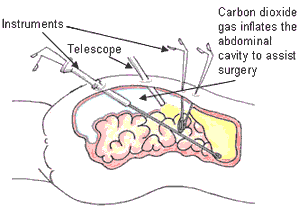

GERD Surgery - Fundoplication
Fundoplication is a type of surgery to correct problems with the lower esophageal sphincter (LES) associated with GERD. Also referred to as the 'wrap' or 'fundo', the fundoplication is the final option for controlling very severe GERD. Because of the possible complications that can accompany this surgery, it is typically done as a last resort. It is by no means a cure for GERD and is only performed when severe symptoms and complications persist.
The procedure involves wrapping a portion of the stomach either partially or completely around the band of muscles at the base of the esophagus. This strengthens LES muscles, allowing the LES to properly close and preventing contents of the stomach from refluxing into the esophagus.
There are two primary approaches:
- Open Nissen fundoplication
- Laparoscopic fundoplication
The operation is basically the same but the way the surgeon gets to the stomach and esophagus is different.
Open Nissen Fundoplication
Until recently, most fundoplication procedures have been the 360° Nissen fundoplication. This is called an open procedure because it requires wide (several inches) surgical incisions. The surgeon wraps the upper part of the stomach (fundus) completely around the esophagus to form a collar-like structure. The collar places pressure on the LES and prevents stomach fluids from backing up into the esophagus. Open fundoplication requires a hospital stay of six to ten days and recovery at home between six and ten months
A laparoscopic fundoplication means that the surgeon will use a few small (1 centimeter) incisions, and small instruments, with the aid of a videoscope and TV monitors to perform the operation. The surgeon creates a collar using the fundus, although the area is smaller to work with.

Laparoscopic Fundoplication
The laparoscopic approach is performed while the patient is under general anesthesia in a modified sitting position. Five small incisions are made in the abdomen. One is used for the laparoscope, the other four are used to retract and manipulate structures in the abdomen. The stomach and the portion of the esophagus in the abdomen are freed from their attachments. The hiatus is tightened with 2-3 sutures to prevent the fundoplication from migrating into the chest.
The "fundus" of the stomach which is on the left of the esophagus and main portion of the stomach is wrapped around the back of the esophagus until it is once again in front of this structure. The portion of the fundus that is now on the right side of the esophagus is sutured to the portion on the left side to keep the wrap in place.
When completed, the fundoplication resembles a buttoned shirt collar. The collar is the fundus wrap and the neck represents the esophagus imbricated into the wrap. This has the effect of creating a one way valve in the esophagus to allow food to pass into the stomach, but prevent stomach acid from flowing into the esophagus and thus prevent GERD.
Laparoscopic fundoplications involve a shorter recovery period, with less scarring and less post-operative discomfort than open procedures. The average in-hospital stay is reduced to three days with the patient fit to return to work in about three weeks.
Laparoscopic fundoplication appears to be safe and effective in people of all ages, even babies. Not all fundoplications can be done laparoscopically because of adhesions from previous operations, excessive bleeding obscuring vision, or in certain patients, including those who are obese or have a short esophagus. It is also generally less successful in relieving atypical symptoms of GERD, including cough, abnormal chest pain, and choking. In about 8% of laparoscopies, it is necessary to convert to open surgery during the procedure because of unforeseen complications.
Fundoplication reduces or eliminates GERD symptoms in most of the patients who undergo the surgery. Studies show that laparoscopic fundoplication improves GERD symptoms in about 6 to 9 out of 10 people who have the surgery (depending on how experienced the surgeon is).
Any type of surgery carries risks, including bleeding and infection. Adverse reactions to anesthesia may also occur. With fundoplication, patients may experience postoperative symptoms such as gas-bloat syndrome (inability to belch or vomit) and dysphagia (difficulty swallowing). In addition, GERD symptoms may recur after surgery. In those cases, patients may require anti-reflux medications or additional surgery.
(see video of laparoscopic Nissen fundoplication)
GERD Surgery- Fundoplication - References
By Mortin - Copyright 2010
Last modification 05/02/2010


Custom Search
Acid Reflux
Heartburn
GERD
Indigestion
Tools & Resources
![]() This site complies
This site complies
with the HONcode standard for trustworthy health information:
verify here.
